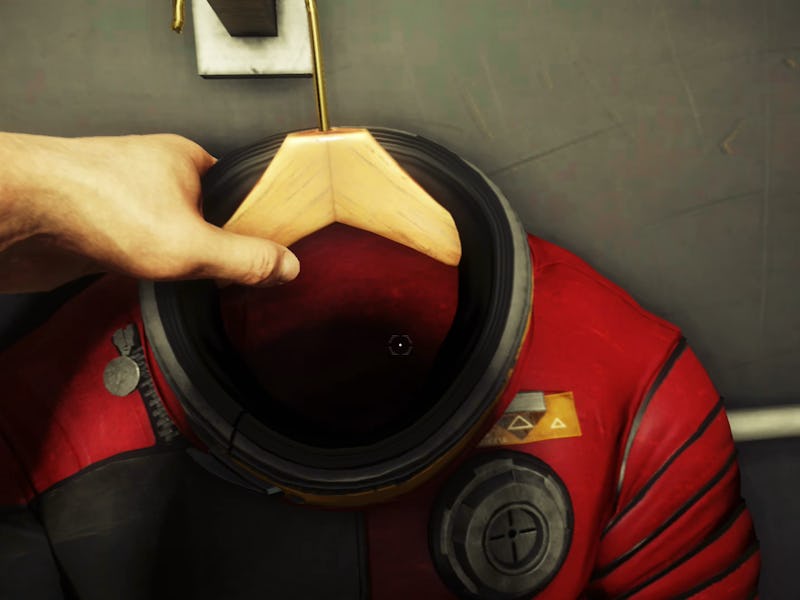There's a Mind-Blowing Moment at the Beginning of 'Prey'
Sometimes, things aren't always what they seem.

The beginning of Prey kicks off like any other single-player video game experience these days, with a sequence briefly explaining some of the core gameplay mechanics while introducing a few of the main characters you’ll share your journey with. First, you’ll pick a male or female Morgan Yu to play as, then you’ll awaken in your apartment a few weeks before your trip up to the Talos I space station to join your brother, Alex Yu. As you explore around your apartment, you’ll find a collection of reading material fleshing out the background of the Prey universe, a handful of emails, and a congratulatory note from your brother on being hired by TranStar. But, once you’ve gathered your things and stepped outside your apartment door, Prey immediately begins to intricately weave what is one of the best introductions I’ve seen in a video game.
Please note, major spoilers for the beginning of Prey are beyond this point.
Once you’ve left your apartment, you’ll proceed down the hallway and bump into a member of the apartment building’s maintenance staff, named Patricia Varma, who prompts you to head to the helicopter on the roof. There, you’ll find a pilot who takes you across a gorgeous vista, serving as the game’s opening credits, before dropping you off at TranStar to meet your brother below for a set of standard tests required by every TranStar employee before heading into space as a researcher on Talos I.
As you take the elevator down into the testing facility, you’ll be greeted by your brother Alex and prompted to head through four separate tests with Doctor Sylvain Bellamy. While strange, they’re all relatively simple tests to complete. But no matter how you complete them, you’ll be met with an awkward, confused response from Dr. Bellamy and his fellow coworkers up until the final testing room.
Here, while answering a series of questions about pushing a single person in front of a train to save a group of people, you’ll watch as Bellamy gets jumped and asphyxiated by a twisted alien creature before being knocked out by gas filling the room. It’s a strange, surprising change in pace but one which ends with you waking up on the exact same day in your apartment building, following the exact same routine you did before.
Now, however, you’ll find emails from a mysterious individual named January on your personal computer telling you it’s dangerous and you need to leave immediately, along with a few of the same objects placed around your apartment in a different order. Immediately, it’s obvious to the player that something’s afoot, and you’ll head out into the hallway once more to be greeted by a dead Patricia holding a wrench you can pick up as a weapon.
Wrench in hand, you’ll be told to escape your apartment by smashing through your locked balcony window, revealing that you were actually aboard Talos I already, locked in the middle of a simulation created to hold you captive as a lab rat to be experimented on. Not only is this the most shocking, thought-provoking moment of Prey’s introduction, it serves as a perfect example for how a video game can easily play with player expectations to make a beautiful narrative experience, which was completely unexpected.
As you escape, you’ll spend time exploring the simulation lab as you work your way to the main lobby of Talos I, where you’ll find all the props and technology used to trick you, the player, into believing the apartment was actually real during the opening section of Prey. There are dozens of the same note used to congratulate you in the props department, stacks of various items scattered around your apartment, and pre-recorded audio paired with the looking glass technology used to simulate your helicopter flight through the city.
You start to compare the various props, audio sequences, and revolving walls to your journey through the beginning of Prey, as you were clueless in the simulated environment. However, things start to come together in a wild way. You’ll find that every locked apartment door led out of the simulation, every secret hatch used to place items in your apartment had a trail of black scratch marks lining the floor in front of it, and various errors in the simulation occurred that you just didn’t (or did) notice.
Look at our favorite maintenance professional, Patricia Varma, for example. If you spoke with her enough and exhausted her dialogue, you’d quickly be met with a severe change in tone and a few suspicious responses, including, “You’re supposed to keep going,” “You’re going to get me in trouble,” and, “I can’t talk to you anymore,” before she goes completely silent. Odd in the simulation sure, but not so crazy once you’ve broken the illusion.
Another glitch occurs during the helicopter sequence on your way to TranStar, right when you take off from the helipad atop your apartment building. While no longer than a millisecond, you’ll notice a small visual glitch in the looking glass technology used to simulate the city: it goes completely blue. Easily dismissed by many, sure, but a valuable piece of the puzzle if you’re able to pick up on it before shattering the glass in your apartment building for the first time.
It’s these little hints and subtle touches that truly make the opening act of Prey feel like something nuanced amidst the many standard introductions we see in video games today, bringing back memories of when I descended into the beautiful underwater city of Rapture or the towering sky city of Columbia for the first time, years ago. It’s a simple, well-crafted approach to introducing players to the world of Prey, and one with purpose we’d like to see more of in the video game industry.